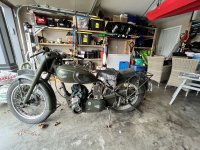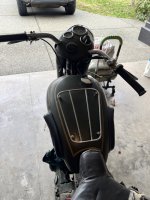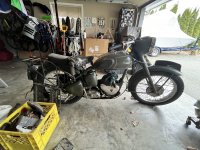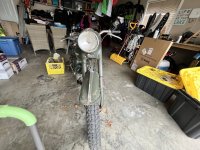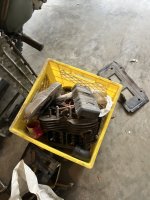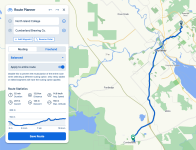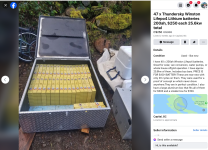- Is it a sin to convert this era of bike? It's certainly a classic.
I'm not familiar with this particular bike so maybe, if this one is rare or has some particular historical value.
In any case, it might be a good idea to try and make the mods reversible while keeping all the ICE stuff in a box somewhere. This way in the future if someone wants to revert it to its original state it will still be possible with minimal effort. It can also help you retain part of the bike's value in case it suddently becomes an expensive collectible, you never know.
- It seems like the main trade off(s) between hub and mid drive is that hubs lack the ability to tune the gearing and lead to an awkward weight distribution. At the same time they make more room for a battery. Is that correct?
Tuning the gearing rarely makes any sense, this is usually some annoying stuff you have to deal with when using an onboard motor. Hub motors provide way enough torque to get going. So basically the first point isn't a real point.
Weight distribution isn't optimal in theory, but it doesn't cause any real life deal breaking problem unless maybe you plan to do races on a circuit, or maybe if you have some absolutely terrible roads with potholes everywhere. For city riding a hub motor is perfectly fine. People tend to overthink this issue, it's not actually that important.
One issue that can arise with hubs is that it's harder to change tires since usually they don't fit in the tire changing machines, so you kinda have to do it manually. It's not exactly easy to do, but after some practice it does get easier.
Also it makes the build a whole lot easier in every aspect, it is likely to be cheaper overall, take less time to build, make overall maintenance easier and leave you with a lot more options for battery size and/or chemistry.
I would clearly go towards a hub if this was my build, this bike seem very adapted for it.
- I see a lot of people here building their own batteries. If I wanted to avoid that, is there even a suitable manufactured battery pack on market for an electric motorcycle?
Not that I'm aware of. I suggest using automotive grade cells if possible.
- If I did build my own battery, how can I best avoid catastrophe? (fire/electrocution)
I think the best way to avoid problems is knowledge and experience. Also, having all the necessary tooling.
First, watch/read as many battery build material as you possibly can, so you'll understand the theory, the risks, the tools needed, etc.
Then maybe try with a smaller battery build. Perhaps you can build a small auxiliary batery that could handle all the 12V stuff. This way you work on relatively safe voltages, you learn to get comfortable without too much risk or cost.
It's not very difficult but there is a learning curve to it.
- How can I spec out the battery requirements?
It all depends on the power you want to have, the desired range and the system voltage (usually determined by the voltage of the controller you plan on purchasing)
For example, you want to have an output power of 10KW, and you have settled on a 84V controller.
Then, since 10KW/84V = 119, you need your battery to be able to deliver peak currents up to 119Amps. You always want your battery to be the most powerful component of your build, so I suggest in this case to make the battery capable of delivering at least 150Amps. This way the cells will be less stressed and should last a lot longer.
These kind of currents can be achieved in two ways: either by having a large capacity pack, or by having a pack capable of high current discharge, meaning it's able to throw a lot of energy during a short time.
Here, capacity is expressed in Ah, and discharge rate is expressed in C.
Lets take two examples:
-You have a battery with a capacity of 150Ah, and a peak discharge rate of 1C : The battery can provide an instant current of 1C x 150Ah = 150A. The battery will be huge and heavy and you will have about 150km of autonomy (very rough estimate, but that's the idea)
-You have a battery with a capacity of 10Ah, and a peak discharge rate of 15C: The battery will be able to provide an instant current of 15C x 10Ah = 150A as well. Meaning that if you were to put both configurations on a dyno they would output the same power. But here the battery will be very small and lightweight and your autonomy should be around 10km. So the bike could be much lighter, which means better acceleration at the expense of autonomy.
So it all depends on the range you need, the current you need and the space/weight constraints.
Some battery chemistries allow for high discharge rates, some other allow for more capacity, there is no perfect battery that fits every application so it completeley depends on your objectives.
- How can I translate battery requirements to weight and size?
First, determine your system voltage and required capacity according to what I described above
Then decide on what chemistry suits your needs.
Then it will depend on what cells are available, their form factor, and the way you can organize them so they fit in your frame.
- How can I determine the best chemistry for a battery?
I'd say it depends on the following:
-Desired discharge rate and/or charge rate (if you often need to charge very quickly that might be important to you)
-Desired safety factor. Some lithium cells can litterally still work after being shot by a shotgun. Some other will catch fire at the slightest puncture or when too hot/overcharged/overdischarged.
-Desired lifetime. Some cells can last thousands of cycles and many years, some others will only last a few hundreds of cycles.
-Weight, volume and price, obviously.
It's always a compromize between these factors, you'll have to decide what matters most to you and choose accordingly
- How the hell can I get a QS motor as a custom motor in the grin simulator?
No Idea.
Hopefully that helps,
